The Role of a Resource Manager: A Key Player in Effective Resource Management
Discover the vital role of a resource manager in effective resource management. Learn their responsibilities, how they differ from project managers, and why they’re key to team success.
Resource management is a big part of making work run smoothly, especially in teams that handle multiple projects at once. But while the term “resource management” often gets tossed around, the role of the resource manager is sometimes overlooked or misunderstood.
In this post, we’ll break down what a resource manager does, how they support teams, and how their role is different from a project manager. Whether you’re part of a growing team or just starting to build structure into your workflow, this guide will help you understand why resource managers matter—and when you might need one.
👉 Need a full overview first? Read our guide that explains resource management.
What Is a Resource Manager?
A resource manager is someone who’s responsible for making sure people are matched with the right work, at the right time, and in the right amount. They oversee how resources (mostly people, but sometimes tools and time) are distributed across teams and projects.
Rather than managing a single project, a resource manager looks at the broader picture. They help balance workloads, avoid overbooking, and ensure no one is sitting idle while others are overwhelmed.
In short, they make sure your people are being used in the smartest, most sustainable way possible.
What Does a Resource Manager Do?
A resource manager’s primary role is to allocate and optimize resources—primarily personnel strategically, but also time, budgets, and equipment—to ensure an organization’s projects and operations run efficiently. They act as a central coordinator, balancing competing demands to maximize productivity while maintaining team well-being. Their day-to-day responsibilities include:
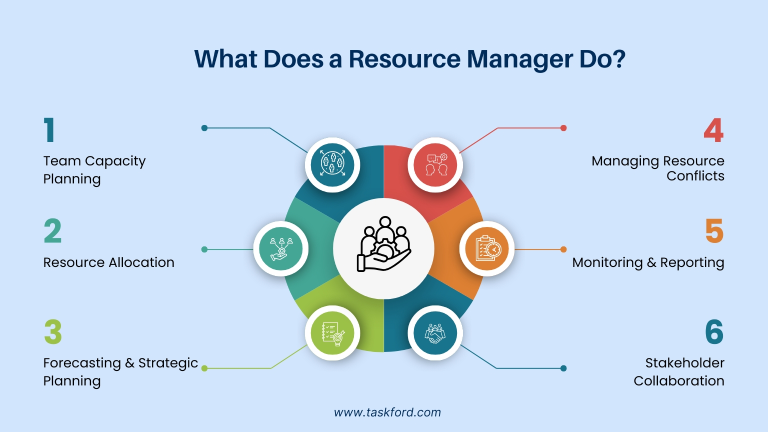
- Team Capacity Planning: Resource managers assess the availability and capacity of team members, accounting for factors like vacation time, part-time schedules, sick leave, and existing project commitments. They ensure workloads are sustainable, preventing burnout by aligning individual capacity with project demands.
- Resource Allocation: They assign team members to tasks or projects based on their skills, experience, availability, and career development goals.
For instance, they might assign a senior developer to a high-priority project while ensuring a junior team member isn’t overloaded with complex tasks.
- Forecasting and Strategic Planning: Resource managers anticipate future resource needs by analyzing upcoming projects, seasonal demands, or organizational goals. They create resource plans to ensure teams are adequately staffed and equipped, preventing last-minute scrambles when new initiatives arise.
- Managing Resource Conflicts: When multiple projects compete for the same resources, resource managers mediate by prioritizing tasks, adjusting timelines, or identifying alternative personnel or solutions.
For example, if two projects require the same data analyst, they might propose redistributing tasks or hiring temporary support.
- Monitoring and Reporting: They track key metrics, such as resource utilization rates, project progress, and team availability, using tools like resource management software. These insights allow them to provide data-driven reports to leadership, highlighting inefficiencies or opportunities for optimization.
- Stakeholder Collaboration: Resource managers work closely with project managers, department leads, and executives to align resource allocation with strategic priorities. They ensure clear communication about resource availability and constraints to support informed decision-making.
By maintaining a comprehensive overview of resource distribution, resource managers ensure projects are adequately resourced, deadlines are met, and teams remain productive without being overburdened.
How a Resource Manager Fits Into Resource Management
Resource management is the structured practice of planning, assigning, and monitoring how your team’s time, skills, and capacity are used. It involves making sure your people are neither overbooked nor sitting idle, and that each project has the resources it needs to move forward.
This practice typically includes a mix of:
- Tools (like workload planners or dashboards)
- Processes (such as forecasting and regular reviews)
- Strategies (deciding when to hire, when to shift priorities, etc.)
But while these systems are important, they’re only effective when someone is actively managing them. That’s where the resource manager comes in.
The resource manager is the person who turns strategy into action. They take high-level resource plans and make them real by answering key questions every day:
- Who is available to take on this work?
- Is anyone over capacity or at risk of burnout?
- Are we using our team’s skills in the best way possible?
- Can we realistically start this new project now, or do we need to adjust?
They sit at the center of all this information, connecting project needs with people’s time and skills. By doing so, they make resource management functional, flexible, and grounded in what’s actually happening on the ground.
In short, without a resource manager, even the best plans can quickly fall apart. With one, resource management becomes an active, ongoing process, not just a one-time plan.
Resource Manager vs. Project Manager: What’s the Difference?
The roles of a Resource Manager and a Project Manager are often confused, especially in growing teams where people wear multiple hats. While both are essential to delivering work effectively, they focus on different things and solve different problems.
Let’s break it down.
What Each Role Focuses On
- Resource Manager: Focuses on people – who’s available, what skills they bring, and how their time is being used. Their job is to make sure the team’s capacity is balanced and no one is overbooked or underused.
- Project Manager: Focuses on the project – what needs to get done, when, and how. They manage timelines, tasks, budgets, and communication to ensure the project is delivered successfully.
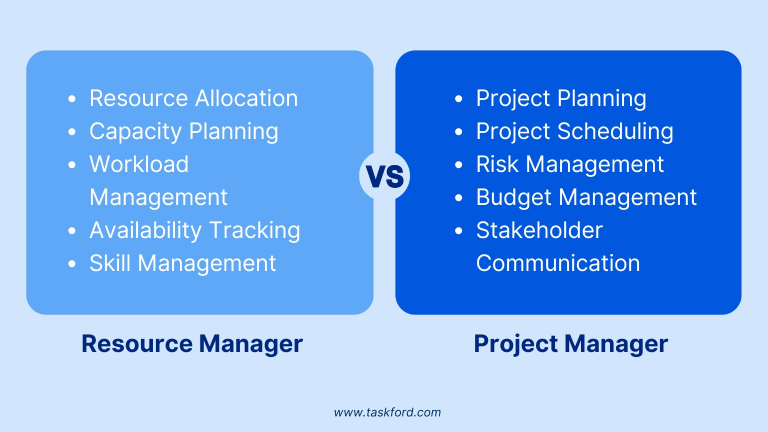
Side-by-Side Comparison
| Aspect | Resource Manager | Project Manager |
|---|---|---|
| Main Focus | People and availability | Project goals and deadlines |
| Scope | Across multiple teams or projects | A specific project or initiative |
| Core Tasks | Assigning people, tracking capacity, resolving resource conflicts | Defining scope, managing schedules, coordinating deliverables |
| Success Looks Like | Balanced workloads, optimized team utilization | On-time, in-scope, on-budget project delivery |
| Primary Tools | Resource planning software, capacity reports | Gantt charts, task boards, project tracking tools |
| Key Collaborations | Works with team leads and project managers to assign the right people | Works with resource managers to ensure team availability |
How They Work Together
A resource manager and a project manager often collaborate closely:
- The project manager defines what needs to be done and by when.
- The resource manager figures out who is available to do it. Together, they balance the project’s needs with the realities of team capacity.
For example, if a deadline moves up, the project manager flags the change. The resource manager checks if the team has the availability or if priorities need to shift elsewhere.
This partnership is key to smooth execution.
What Makes a Good Resource Manager?
A great resource manager combines strategic thinking with strong interpersonal skills. Key qualities include:
- Analytical Skills: The ability to assess data on workloads, skill sets, and project demands to make informed decisions.
- Communication: Clear, proactive communication with project managers, team members, and stakeholders to align expectations.
- Problem-Solving: The knack for resolving conflicts, such as competing project demands or resource shortages, creatively and efficiently.
- Empathy: Understanding team members’ strengths, limitations, and career goals to assign tasks that keep them engaged and motivated.
- Organization: Juggling multiple projects and priorities while keeping track of who’s doing what and when.
A good resource manager is both a planner and a people-person, ensuring resources are used wisely while keeping the team’s well-being in mind.
How TaskFord Helps Resource Managers Work Smarter
Being a resource manager means keeping track of a lot—people’s time, project needs, shifting priorities, and capacity across multiple teams. Without the right tools, it can quickly become overwhelming.
TaskFord is designed to make this work easier, clearer, and more connected. It helps resource managers focus on what matters: assigning the right people to the right work, avoiding overload, and staying ahead of problems before they grow.
Here’s how TaskFord supports resource managers in their day-to-day work:
Capacity Planning & Workload Tracking
Understanding how much each person can take on is the foundation of effective resource management. TaskFord provides a real-time view of team capacity planning across roles, departments, and projects. You can easily:
- See who’s overbooked or underutilized
- Visualize workloads by day, week, or project
- Spot uneven distribution early and rebalance assignments
- Avoid last-minute conflicts or bottlenecks
This makes it easier to keep your team productive, without burning anyone out.
Learn more about TaskFord’s solutions for Resource Management
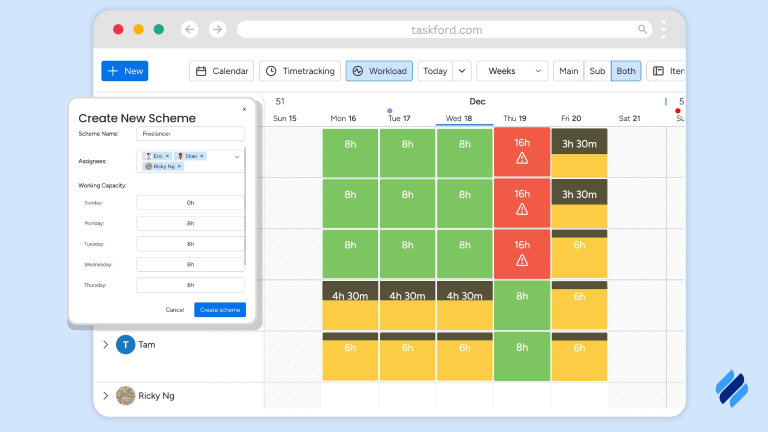
Smarter Resource Allocation
Assigning the right person to the right task isn’t just about availability—it’s about skill fit, project priority, and timing. With TaskFord, you can:
- Filter team members by role, skill set, or workload
- Allocate resources based on actual availability, not guesswork
- Coordinate across teams and departments from one place
- Adjust assignments with drag-and-drop simplicity
This helps avoid the scramble that often happens when project timelines shift or new work comes in unexpectedly.
Discover more Resource Planning in TaskFord
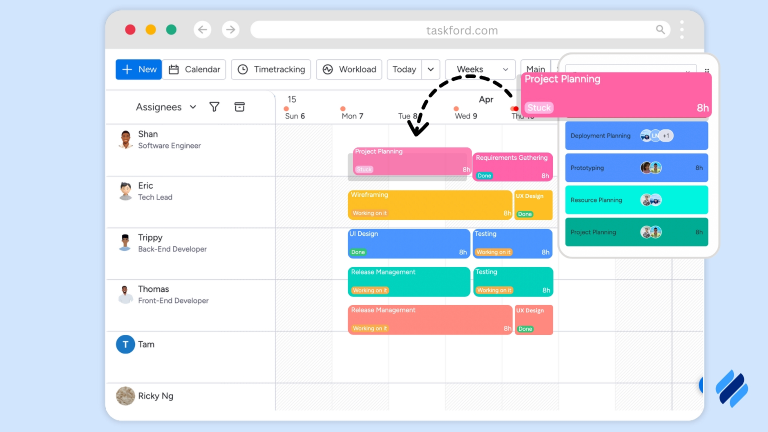
Planning Time Off Without Disrupting Team Flow
Time off is a normal part of team life, but it can derail projects if not planned for. TaskFord lets you:
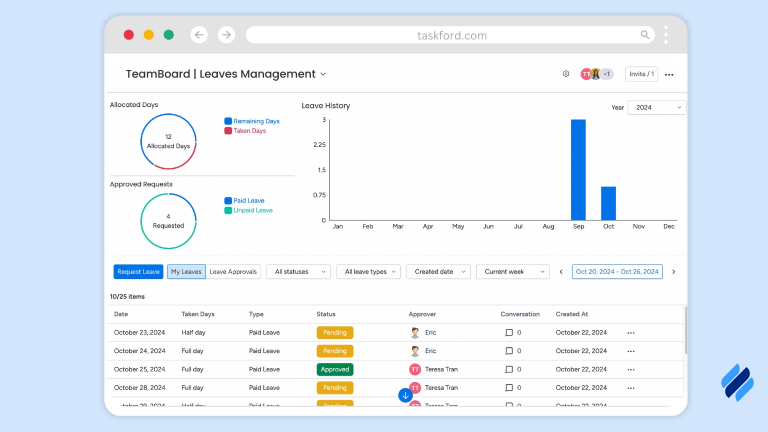
- Log and track vacations, holidays, and leaves
- Automatically adjust team capacity during time-off periods
- See time-off overlaps that might impact coverage
- Reallocate work in advance to avoid last-minute handoffs
This ensures your team can rest, without putting project delivery at risk.
Real-Time Tracking & Timesheets
Having accurate data on how time is actually spent helps resource managers refine planning and respond to reality, not assumptions. With TaskFord’s built-in timesheets and tracking features, you can:
![]()
- Monitor actual hours logged vs. planned
- Use timesheet insights to forecast future work more accurately
- Get visibility into where effort is going across the team
This level of tracking helps you make adjustments based on real use, not just plans.
Stay on Budget with Cost Tracking
Resource management isn’t only about time, it’s also about cost. With TaskFord, you can connect your team’s hours to budget impact. You’ll be able to:
- Track time and cost across tasks, people, and projects
- See how team utilization affects project budgets
- Compare planned vs. actual costs in real time
Discover more TaskFord’s solution for Budget Management
![]()
This helps resource managers and finance leads stay in sync while making better, more informed decisions.
In Short, TaskFord isn’t just resource management software – it’s a full resource planning system.
Final Thoughts
At its core, resource management is about people, not just numbers, charts, or plans.
The resource manager’s job is to help those people do their best work, without burning out or getting pulled in too many directions. They’re the ones connecting the dots between what’s needed and what’s possible.
With the right approach—and the right platform like TaskFord—resource managers help teams stay focused, balanced, and ready for whatever comes next.
Subscribe for Expert Tips
Unlock expert insights and stay ahead with TaskFord. Sign up now to receive valuable tips, strategies, and updates directly in your inbox.